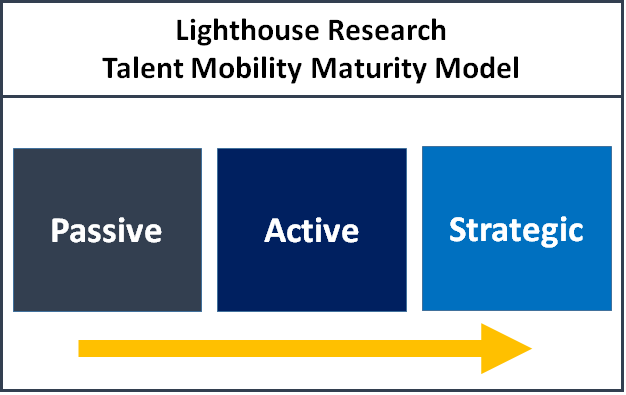One of our specialties at Lighthouse Research is diving into internal talent mobility. We’re talking with vendors that sell the technology. We’re working with companies that are adopting these practices. And in a recent webinar with WorldAtWork, we explored multiple case studies of employers that have innovative or unique approaches to talent mobility. But we still get a lot of questions around the adoption points: leadership buy-in, getting managers on board, and more. Let’s answer these questions and help set the record straight: talent mobility is a powerful practice for engaging, developing, and retaining your employees.
 Question One: What if we’re a smaller company or have few opportunities?
Question One: What if we’re a smaller company or have few opportunities?
Smaller companies obviously run into logistical challenges of not having as many open jobs to transition employees into, but that doesn’t mean they are exempt. Employees still have the fundamental need and desire for development and growth. That said, the best way to start exploring this as a small company is to look for ways to implement crosstraining opportunities similar to Hootsuite’s model. People get to “try out” a new department or role for three months (one day a week). They are stretching their networks and their competencies while contributing to two separate departments in the organization. For good performers, this is a winning strategy all around.
Question Two: How do we get our leadership to buy in to a talent mobility strategy?
Companies that fall on the Strategic side of the Lighthouse Research Talent Mobility Maturity Model really look beyond the simple returns on employee retention and into deeper company value that comes from practicing talent mobility. For example, not only are employees staying (retention), but they are more satisfied (engagement) and more productive. Or employees that feel like they have a future (via talent mobility) are more likely to share their most innovative ideas with their employer instead of keeping them close to the vest. Gallup’s data says that highly engaged employees, which we would expect within a company focused on talent mobility, are about six times more likely to say that their job brings out their most creative ideas.
Question Three: Our managers don’t want to lose their good people, how do we address this?
The bottom line is that managers are already losing their good people–to the competition. Instead of having the majority of those employees walk over to your competitors and give them their efforts, ideas, and innovations, why not give talent mobility a try as a way to keep those employees in-house? The step that most managers have trouble with is seeing the employee as a resource of the company, not just a resource on their team or in their department. i4cp’s data on “talent hoarding” tells us that managers who try to hold onto their people instead of encouraging mobility can actually hamper business performance overall.
Question Four: Won’t talent mobility disrupt operations?
In some cases, it might. But then again, people leaving a job is always disruptive, right? If the best employee in your department resigned today, how disruptive would that be to your plans and your team’s productivity? Instead, if that person had an off-ramp to transition to another team internally, you’d still have the opportunity to reach out and tap them on the shoulder for ideas and questions when you otherwise couldn’t had they left the organization. In short: think about the alternatives and you’ll realize that as disruptive as talent mobility is, it is no more disruptive than the alternative of losing your best and brightest team members.
Question Five: We are always asking for referrals. How do we get employees to realize they can opt in as candidates themselves?
Employees need to feel some responsibility for their own careers, and part of that is having managers regularly ask open-ended questions about employee preferences, interests, and aspirations. Tata Consultancy Services, a firm with thousands of employees globally, has a standard practice where at the end of manager one-on-one’s, employees get to talk about their aspirations. They are actually encouraged to share their career dreams and hopes. In some companies, though, that kind of conversation is not encouraged (or even downright discouraged). Employees need to know that opting in to the recruiting process is not a bad thing. Companies can also take the approach of Credit Suisse’s recruiters and dial internal candidates just as if they were external applicants, presenting them with career options and opportunities. This takes away some of the fear for employees because they have “permission” to respond when a recruiter calls them.
Interested in talking with us about talent mobility? Feel free to reach out to our team for more information.

Ben Eubanks is the Chief Research Officer at Lighthouse Research & Advisory. He is an author, speaker, and researcher with a passion for telling stories and making complex topics easy to understand.
His latest book Talent Scarcity answers the question every business leader has asked in recent years: “Where are all the people, and how do we get them back to work?” It shares practical and strategic recruiting and retention ideas and case studies for every employer.
His first book, Artificial Intelligence for HR, is the world’s most-cited resource on AI applications for hiring, development, and employee experience.
Ben has more than 10 years of experience both as an HR/recruiting executive as well as a researcher on workplace topics. His work is practical, relevant, and valued by practitioners from F100 firms to SMB organizations across the globe.
He has spoken to tens of thousands of HR professionals across the globe and enjoys sharing about technology, talent practices, and more. His speaking credits include the SHRM Annual Conference, Seminarium International, PeopleMatters Dubai and India, and over 100 other notable events.
